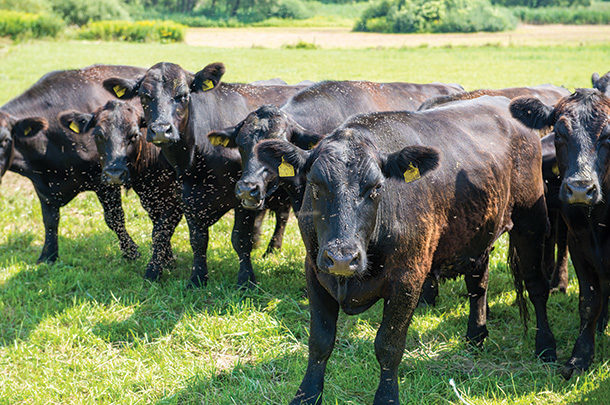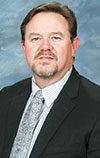Every year about this time, producer attention turns to fly control. Especially in the southern U.S., by the time early spring rolls around, the flies are coming back to the cows with a vengeance, assuming they ever left at all. Cows in colder regions get at least something of a break from these pests.
Various studies have estimated the annual expense to the industry can exceed $1.5 billion annually. Horn flies alone are estimated to cost cattle producers well over $850 million. To the individual producer, a heavy infestation may cost $30 to $50 or more per head per year.
First a little review
There are several species of flies that create problems for the cow herd. For instance, horn flies are aggressive blood suckers and each individual fly can consume 20 to 30 “meals” of the animal’s blood per day. This means that important and expensive nutrients consumed are required not only for animal maintenance and production requirements but also a significant portion of these nutrients must be directed to blood synthesis. Heavy populations can also cause high levels of stress, affecting the animal’s ability to efficiently use the nutrients it consumes. This stress also goes on to depress immunity in the animal, making it more susceptible to a variety of diseases.
Other species of flies also cause problems for cattle. Face fly adults closely resemble house flies except they are slightly larger and darker. The face fly is a non-biting/sucking fly that feeds on animal secretions clustering around an animal’s eyes, mouth and muzzle, causing extreme irritation. Face flies will also feed on blood and other secretions around wounds caused by mechanical damage, injury or feeding sites from horn or stable flies. Face fly feeding causes damage to eye tissues and increases susceptibility to eye pathogens, particularly Moraxella bovis, the causal agent of pinkeye.
Stable flies are serious pests for all cattle. Like horn flies, stable flies are blood feeders, persistently feeding on the front legs and under line of cattle. Their bites are very painful; cattle will often react by stomping their legs, bunching at pasture corners, or standing in water to avoid being bitten. The female stable fly deposits eggs in spoiled or fermenting organic matter mixed with animal manure, soil and moisture. Winter-hay feeding sites where hay rings are used can often be a source for larval development through the summer if adequate moisture is available.
House flies are believed to cause economical losses approximating $750 million. Organic matter, manure and waste are their main food sources. Since house flies have a spongy mouthpart and thus do not bite, puncture or suck blood, the losses are related largely to nuisance or irritation. A bigger concern is that houseflies are known to carry over 100 pathogens.
Feed-through fly control
A number of products have been developed showing effectiveness in helping reduce fly populations on cattle. These products can be delivered in feed, mineral, tubs and liquid feeds and act in different ways to control flies. There are three general product types of feed-through fly control products currently on the market.
1. Altosid
Chemical name: S-methoprene
Manufacturer: Central Life Sciences
Altosid is commonly referred to by its application name of IGR or insect growth regulator. When fed to the animal, methoprene passes through the digestive tract in an inert form. It is not absorbed into tissues and has no effect on the animal. Altosid ends up in the manure of the animal and will be consumed by fly larvae when horn flies deposit their eggs in fresh or reasonably fresh manure. Once consumed, methoprene will prevent growth and development of the larvae so they never develop into mature flies that can emerge from manure. Altosid is labeled for the control of horn flies.
2. Justifly / Clarifly
Chemical name: Diflurbenzuron
Manufacturer: Champion Animal Health / Central Life Sciences
Justifly and Clarifly are the same chemical manufactured and sold by different companies under different names. Both are feed-through products like Altosid and pass through the gut ending up in the manure. The active chemical, diflurbenzuron, is considered a larvicide and affects the development of certain larvae body tissues, preventing complete development into a mature fly. What makes this product type unique is that it is labeled for the control of horn, face, stable and house flies, thus providing a broader-spectrum fly control.
3. Rabon
Chemical name: Tetrachlorvinphos
Manufactured for: Bayer Healthcare LLC
Like Justifly and Clarifly, Rabon is labeled for the control of horn, face, stable and house flies. It is considered an insecticide and will kill fly larvae in the manure on contact. In a wettable form, it may also be used for external applications on cattle and some other species.
All four of these products can be used in feeding and supplementation programs to help in the control of fly populations on a given cattle operation. Like any other product, they are not a silver bullet, and there are considerations to be made. Producers need to understand the limitations and what is realistic:
- Each product will control the species of fly or flies as indicated. This will depend on the animal consuming an appropriate amount of the product through the feed or supplement. Free-choice supplements such as minerals may not be consumed equally by all cattle in each pasture or pen. If an animal does not consume the feed or supplement containing the product, the larvae in that animal’s manure will not be affected.
- The product will control the growth and development of the specific fly larvae in the manure of the animal to which it is fed. It will not control flies emerging from old hay piles, last year’s manure, or accumulated organic matter (rotting leaves, wood, etc.) in wooded areas, creek bottoms and so on.
- Flies are known to travel long distances. House flies are known to travel up to a mile. Flies on your cattle may come from your neighbor’s place or from even farther off.
- Environmental conditions can affect fly populations. If conditions are right (warm/hot, wet), fly populations may be greater than expected.
- Understand that even when feeding a product such as those listed, you may still have flies on your cattle because of the reasons listed above. By feeding these products, you increase your chances of reducing the overall fly population, and this is beneficial. If you still have flies even when feeding one of the products, consider what that population might be if you did not.
- A good fly control program should be made up of several mitigating steps such as those described.
- Feed-through products should be started early in the spring and fed consistently (not on and off) until the first good frost.
Conclusions
Feed-through fly control products are a useful tool in the effort to control flies on your cattle and overall cattle operation. They require very little additional management except what is required to feed the product through a mineral supplement, feed, etc. Consistency is a key. As with any product or practice, there is a cost involved. The cost should be evaluated as part of a sound parasite control program.












